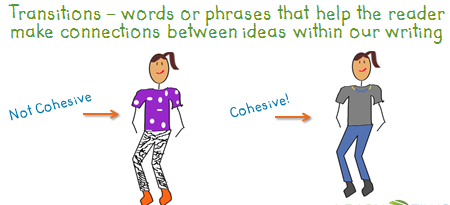2.3 Writer's Workshop: Persuasive Argument
| Site: | Cowichan Valley School District - Moodle |
| Course: | ELA7, CSS, Sferrazza |
| Book: | 2.3 Writer's Workshop: Persuasive Argument |
| Printed by: | Guest user |
| Date: | Tuesday, 30 December 2025, 3:34 AM |
Writing Goal: Persuasive Argument
Imagine you’re sitting in the waiting room at the dentist’s office. The receptionist says you’ll have about a fifteen-minute wait. The last thing you want to do is think about what’s going to happen while you’re sitting in the dentist’s chair, so you grab a magazine and start flipping pages.
You stop to look at an advertisement for a new brand of toothpaste that promises to whiten your teeth in just ten days. The model in the ad has a perfect smile. Wouldn't it be great if the orthodontist could make your teeth look that fantastic? Just in case he can't, you decide to buy a tube of this amazing new toothpaste.
You flip a few more pages and the title of an article catches your eye—The Importance of Preventing Sunburns. You read the article and are shocked to discover that young people are being diagnosed with skin cancer. You still plan to go to the beach with your friends this weekend, but you’ll definitely remember to take sunscreen. In fact, you can pick up some at the drug store when you buy the toothpaste.
The dentist’s assistant calls out your name. Wow! Those fifteen minutes flew by.
And in that brief time, you were persuaded to buy a new product and think about a way to protect your health.
That’s the power of persuasion!
Workshop Overview:
- First, you need to choose an issue you want to convince someone about.
- Then, you need to identify your position on the issue.
- Next, you need to research information about your issue to include in your argument and outline a plan for your persuasive argument essay and speech.
- You need to write your essay.
- Finally, you need to practice presenting it as speech.
 Writing Targets:
Writing Targets:
By the end of this workshop you will have incorporated the following into your piece:
- A clear opening statement
- At least three supporting points in your body paragraphs and your speech that are supported by facts, examples, statistics, quotations, and occasionally emotional appeals
- You have identified and responded to opposing views
- A clear closing statement
- A highly persuasive argument
- Confident, fluent and engaging oral presentation
You are going to be writing a persuasive or argumentative essay using a specific essay format. You will need to choose an issue or concept that you have an "opinion" about, that is meaningful, and that you can support with facts and information in order to convince others that your opinion is a reasonable one. You need to choose your topic carefully and it must be on the theme of the stewardship of nature.
The following ideas may appeal to you or you may have an idea of your own that is not on the list below:
1. First Peoples' should regain rights to their lands.
2. People need to spend more time outside.
3. Alberta's oil sands are causing ecological harm OR Alberta's oil sands are justifiable.
4. Green cars are not green.
5. Connecting with nature has many important benefits.
6. Destruction of the world’s forest is justified by a human need for land and food.
7. Garbage disposal should not be free to encourage recycling
8. Do animals have rights? Using animals for scientific research is inhumane.
9. Hunting is unethical and should not be allowed.
10. The Northern Gateway Pipeline project in BC should not be passed.
11. Leather and fur clothes should be outlawed.
12. Wind power plants help reduce effects of global warming.
13. Government should ban plastic bags.
14. Whaling should be prohibited.
15. There should be mandatory water rationing during drought conditions?
Before you begin, take a moment to complete a mini-lesson on pronouns. The mini-lesson can be found on the main page after this book module. Return to the book module when you're done.
 Once you have chosen your topic you can begin your research.
Once you have chosen your topic you can begin your research.
Open your writer's notebook and complete 2.1 Arguments For & Against. Use the chart as you complete your research. Be sure to keep track of the websites and texts you use as you will be required to submit a bibliography.
Research your issue using a variety of sources, such as the Internet, newspapers, books, and magazines. You might even interview people who are involved or affected to hear their side of the story. Look for information that can be proven (facts rather than opinions) as it is most persuasive.
Be sure to include notes/information that will allow you to create three or more arguments that support your opinion and at least one counter-argument that opposes it.
Once you've gathered your research notes you can begin planning for your essay. Look for the strongest arguments that can be supported with the most/strongest evidence.
Open your writer's notebook and complete 2.2 Concept Map.
Now that you have completed your concept map, you are ready to create more elaborate plans for your essay. The more time you spend planning, the easier your essay will be to write. There will be less editing for you to do in the end and there will be better flow to your writing.
Open your writer's notebook and complete 2.3 Persuasive Planning Sheet.
One way to convince people about something is to write a persuasive argument. A typical persuasive argument contains a powerful opening, a body with supporting reasons, and a convincing conclusion. In this lesson, we will focus on the opening.
Open Strongly
The opening of a persuasive argument is where you introduce the topic and state your position (point of view) on it. It should “grab” your reader’s attention and make him or her want to read on.
Here is an Example:
Did you ever wonder who made those designer jeans and fancy running shoes you’re wearing? If you found out it was a child working for pennies a day in a smelly, crowded factory, rather than going to school, would you still buy those clothes? I doubt it very much. Child labour is a serious problem in some parts of the world. We need to shop carefully so we don’t support businesses that employ child workers.As you can see, the opening of a persuasive argument catches your interest and introduces an important issue. It also includes the author’s position on the issue. Evidence to support that position will come in later paragraphs.
Copyright 2007, Open School BC



For your opening statement to be really effective, you need to know who will be viewing, hearing, or reading it. You should always keep these points in mind.
-
Does your audience know you?
-
Do you think your audience agrees or disagrees with your point of view?
You might need to add more points and examples for an audience that is not likely to share your point of view. Otherwise you could end up writing a persuasive argument that isn't convincing.
Open your writer's notebook and complete 2.4 Opening.
Once you have completed your outline and are satisfied with it, you’re ready to write a first draft of your persuasive argument. This is where you “connect the dots” and write out your ideas as full sentences and paragraphs.
The following are suggestions when you write your first draft:
Write one paragraph for each of your main ideas. Each paragraph should clearly support your position. You should have at least 3 paragraphs.
-
Try to use facts wherever you can, rather than just opinions. Facts are powerful persuaders.
-
Introduce the counterarguments then show why your arguments are better. You should have at least one counterargument.
-
Save your best argument for your final paragraph.
-
Connect your arguments with transition words like however, furthermore, and in addition. Or you could number your points, e.g., firstly, secondly, etc. Here’s a list of commonly used transitional words and phrases:
|
and |
unlike |
in contrast |
in other words |
sometimes |
|
but |
however |
furthermore |
to sum up |
in addition |
|
or |
yet |
on the other hand |
consequently |
besides |
|
while |
unless |
similarly |
first |
likewise |
|
although |
therefore |
because |
next |
for instance |
 Begin writing your first draft now! Once you have done so, upload your draft to the Persuasive Easy Dropbox.
Begin writing your first draft now! Once you have done so, upload your draft to the Persuasive Easy Dropbox.


An action point is a sentence telling you reader what action they should take.
Once you've written your conclusion ask yourself;

Open your writer's notebook and complete 2.5 Conclusion.
Revising is your chance to improve your first draft by adding, deleting, changing, and moving ideas around. You may need to revise your persuasive argument two or three times before you’re fully satisfied with it.
As yourself these questions as you revise your work.
-
Did I state my position clearly?
-
Is my position evident throughout my argument?
-
Are my opinions clear and do my facts support my opinions?
-
Do my paragraphs flow well together?
-
Do I stay on topic?
-
Did I mention the counter-arguments? Did I prove why they are wrong or insignificant?
-
Is my argument convincing?
-
Does my information flow easily from one paragraph to another?
You should also revise your work to eliminate any errors in logic. A logical argument has to be reasonable and make sense. If yours isn’t, then it won’t be very persuasive.
Some common errors in logic include:

Revision is where your writing is taken to the next step.
Your teacher has given you feedback on one or more items to revise in your writing.
Return to the draft of your essay to revise based on those comments and any other revisions you might want to make. This is an important part of the writing process and you will be marked on whether or not you were able to make the necessary revisions.
To complete this assignment, Click HERE to download the template.
Part A: Provide 3 examples of the revisions you made to your essay. Include both the original and revised sections.
Example:
Original: "Arctic drilling may not be perfect, but it will probably help us stop using foreign oil at some point. This, I imagine, will be a good thing."
Revised:Time and time again, science has shown that arctic drilling is dangerous. It is not worth the risks environmentally or economically."
Part B: Incorporating Transitional Words or Phrases
Earlier in this unit we discussed the importance of transitional words or phrases.



Once you have completed the exercise upload your document to the Persuasive Essay Revising Dropbox.
 Once you've gone through and made all necessary revisions, begin editing your essay.
Once you've gone through and made all necessary revisions, begin editing your essay.

Editing is where you make sure everything reads smoothly.
Check that you have done each of these things:
Parts of Speech:
Did I use a consistent verb tense (e.g. past or present) throughout my writing?
Do my singular subjects have singular verbs and my plural subjects have plural verbs?
Did I use the best words in my writing?
Sentences
Do all my sentences express complete thought?
Have I eliminated run-on sentences from my writing?
Have I eliminated short, choppy sentences from my writing?
Have I eliminated long, rambling sentences from my writing?
Did I use a variety of words and phrases to start my sentences?
Have I eliminated words that don't add meaning to my sentences?
After you have edited your story, read it aloud at least once. Let your ear tell you what sounds awkward or ungrammatical.
I have read my story aloud at least once.
Once you are satisfied with your editing, it's time to proofread your writing. Proofreading deals with the more mechanical aspects of your writing. Check your writing for these points.
Title
Have I included a title?
Punctuation
Did I include a punctuation mark at the end of each sentence?
Did I use commas to separate items in a series?
Did I use commas before conjunctions (e.g., and, or, but) in compound sentences?
Did I correctly punctuate the dialogue in my writing?
Did I use apostrophes to show possession or missing letters (not plural)?
Capitalization
Did I begin each sentence and direct quotation with a capital letter?
Did I capitalize nouns that name specific people, places, and things?
Spelling
Have I double-checked the spelling of the names of people and places?
Did I use the correct word form for words that sound alike but have different spellings and meanings (e.g., their, they're, there; too, to, two)?
Did I use the spell-check function on my computer?
Paragraphing
Have I indented each new paragraph or double-spaced it from the previous paragraph?
If there is dialogue, have I started a new paragraph each time the speaker changes?
Sometimes it can be difficult to spot mistakes in your own work, so you could ask a friend or family member to proofread it as well.
 Once you have:
Once you have:
- completed the personal revision task
- revised your first draft based on feedback from your teacher
- edited your work for COPS
- checked the rubric to make sure you have included all necessary elements
- you are ready to submit your final draft!
Submit under the dropbox: Persuasive Essay: Final Draft